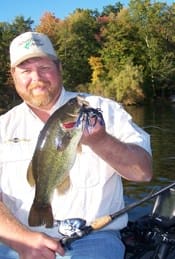
When you go fishing, if you want to catch a fish, it’s really important that you put your bait where the fish live. It’s the most basic concept of fishing. You can have the nicest boat in the world, and you can have lots of expensive rods, reels and tackle boxes full of lures, but if you don’t put your lure near a fish, all that other stuff will do you no good. Here are some ideas for finding different species of fish in the fall months throughout the Midwest.
Let’s start with crappies. Crappies are abundant and popular almost everywhere. During the spring, we catch them near cover like rushbeds, docks and timber in shallow water. However, in the fall, if you fish those areas, you more than likely will not be eating crappies for supper. You just can’t find many in shallow water during autumn.
In some lakes, the crappies will be on or near the deep weedline. The clearer the water, the deeper they’ll be. Sometimes they’ll be 25 yards off the edge of the deep weedline. On a calm evening, you can see them creating dimples as they suck bugs from the surface of the water. Throw two-inch Power Grubs or Slurpies Swim’n Grubs on one-sixteenth-ounce jigs, and you’ll catch crappies.
Crappies will also be found on the bottom in the basin of some lakes. Cruise the basin in 25 to 30 feet of water with a close eye on your sonar. When you see a concentration of fish, work them with one-eighth- or one-sixteenth-ounce Fire-Ball jigs tipped with minnows.
Walleyes can be in a lot of places depending on the lake. Different lakes provide different hangouts. In shallow lakes, you can find walleyes on windblown points in two feet of water.
In clear lakes with a lot of depth, walleyes can be found as deep as twenty feet or more on structures like rock piles or deep points. They’ll suspend away from structure near baitfish in some bodies of water, and they’ll go on a night-bite in some lakes. Research the lake you’ll be fishing to determine where you should focus your efforts.
Largemouth bass will also be in different areas, but as the weather gets colder, you’ll find fewer of them in the sloppy shallows that many inhabited during the summer. However, on a warm day in the fall, especially at mid-day, you can find them cruising reed beds near deeper water. Reed beds in six to eight feet of water that are close to cabbage beds in twelve to fifteen feet of water can be very good. The bass hold in the deeper water during cold conditions, then move to the more shallow water when there’s a day or two of warmer weather. Throw a Pro-Model Reed-Runner Spinnerbait and add a four inch Power Grub to increase the bulk. Big bass like bulky baits in the fall.
The thing we need to recognize is that some lakes have more options than others for fall fish. Some of them have limited types of structure that will hold fish. On other lakes, you need to try different methods to get bit. Keep that in mind, and you’ll have no problems getting bites.
To see all the newest episodes of Fishing the Midwest television, visit MyOutdoorTv.com, orfishingthemidwest.com.



